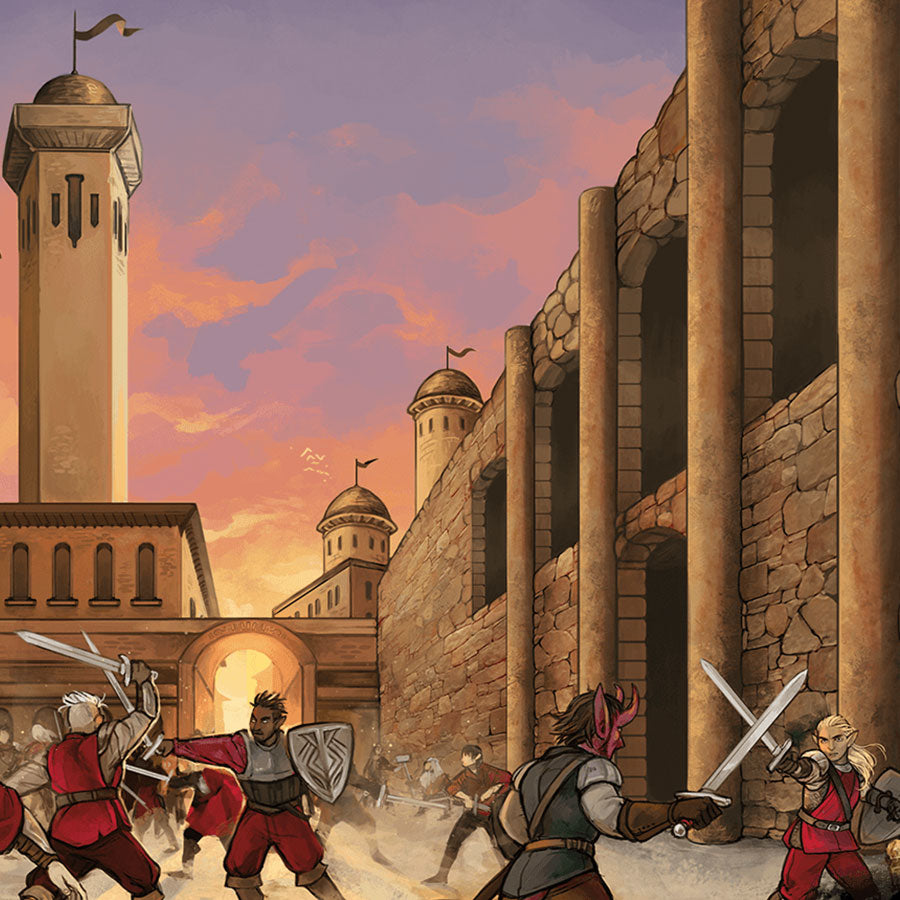3 City Campaign Mistakes to Avoid in D&D

Written by Luke Hart
I think lots of folks are intimidated by running D&D campaigns in large cities, but I honestly don’t think they are beyond most game masters’ skill sets. I feel like even new game masters could successfully run enjoyable city campaigns if they want to. You see, city campaigns are NOT exclusively the domain of experts or veterans.
So, why is it that we can often think that? Like, lots of folks think that running a D&D campaign in a city is super challenging, and they simply steer clear. And I think this is because we can have certain misconceptions about running city campaigns – we’ll call them pitfalls of perception. These are the things that cause us to believe city campaigns are super hard to run and the domain of experienced dungeon masters alone.
So, let’s talk about these three common pitfalls of thinking that – I believe – once you shatter, you’ll find that running a City Campaign, while perhaps still challenging, is certainly within your reach.
Watch or listen to this article by clicking the video below.
Pitfall #1: Assuming that City Campaigns Are Sandbox Campaigns
One of the biggest misconceptions about city-based campaigns is the belief that they need to be sandbox games where players can go anywhere and do anything. This assumption can lead to unnecessary anxiety for Dungeon Masters, who feel they need to prepare every nook and cranny of the city in advance. But here’s the truth: a city campaign doesn’t have to be a sandbox, and it certainly doesn’t have to be open-ended.
In fact, many successful city-based campaigns follow a more traditional RPG structure where players are presented with plot hooks that guide their actions. As a Dungeon Master, you can offer multiple hooks or paths for players to choose from, but you can still control the general direction of the game. While the characters may have the freedom to explore, they should still be drawn toward the adventures you’ve prepared.
Example
In my own city campaigns—many of which have been set in Waterdeep—I've never run a true sandbox. Instead, I provide the party with a few plot hooks at a time, keeping the focus on the main problem or story arc. The players may feel like they have freedom, but I always guide them with intentional plot hooks.
If your players are aimlessly wandering the city, it might be a sign that you haven’t provided compelling enough plot hooks, or that your group needs to have a conversation about the game’s direction. Creating strong, clear plot hooks will keep the campaign from stalling and give your players purpose in their exploration.
Key Takeaways
- Avoid open-ended sandboxes. Use plot hooks to guide the players, even if the setting feels open.
- Focus on compelling hooks. Well-crafted plot hooks should naturally draw the players toward the adventures you've prepared.
- Communication is key. If players are wandering aimlessly, consider revisiting your session zero agreements and ensure everyone is on the same page.
Pitfall #2: Making the Campaign All About Politics
Another misconception is that a city campaign must revolve around politics. While politics can certainly play a role in a city setting, they don’t have to dominate the story. City-based campaigns offer a wealth of adventure possibilities beyond political intrigue, and you can still run traditional dungeon-delving, investigation, or faction-based adventures within a city.
A city should serve as a hub where your players can encounter different types of adventures, from classic dungeon crawls in the nearby wilderness to undercity delves or faction conflicts. Politics can be a background element or the focus of only some adventures, rather than the entire campaign.
Examples of Non-Political City Adventures
- Sewers and Underdark. In a city like Waterdeep, for instance, sewers or hidden tunnels might lead to the Underdark, providing plenty of opportunities for combat and exploration.
- Faction Conflict. Factions in the city might hire adventurers to assist with their goals, whether that’s taking down a rival faction or infiltrating a thieves' guild.
- Classic Villains. Even in a city, traditional villains and crime lords can take center stage. Perhaps they evade the law or have too much power for the city guard to handle, leaving adventurers as the city’s last hope.
Remember, city-based campaigns are only limited by your imagination, and they don’t have to focus entirely on political maneuvering to be engaging and exciting.
Key Takeaways
- Avoid all-politics campaigns. Cities provide many adventure opportunities—don’t feel limited to political intrigue.
- Mix up the adventure types. Include dungeons, faction conflicts, investigations, and traditional villains in your city game.
- Use the city as a hub. The city should feel alive, but it doesn’t have to be the sole focus of every adventure.
Pitfall #3: Creating and Fleshing Out EVERYTHING in the City
One of the biggest traps Dungeon Masters fall into when running city campaigns is the urge to flesh out every single detail of the city. While it’s tempting to create a fully realized world with detailed NPCs, shops, and locations, it’s a huge time sink that will likely result in wasted effort. You simply don’t need to prepare the entire city in advance.
Instead, focus on the core elements you know the players will interact with. Prioritize the key locations, NPCs, and factions that will drive your campaign forward. If your players wander off the beaten path, you can improvise or prepare new areas as needed for the next session. This saves you time and effort while keeping the game flexible.
What You Should Flesh Out
- City Basics. Determine the type of government, the population, and the overall structure of the city (wards, districts, key landmarks).
- Key Locations. Prepare a few taverns, inns, shops, temples, and perhaps a palace or guard outpost. These are locations players are most likely to visit.
- NPCs. For each key location, have a few NPCs in mind. These could include tavern owners, shopkeepers, guards, or high priests.
- Culture and Background Events. Adding festivals, holidays, and local customs will help bring the city to life without needing to flesh out every detail.
By focusing on the essentials, you’ll save time and be able to respond flexibly to player decisions. You can always build out more details if needed, but there’s no need to over-prepare.
Key Takeaways
- Don’t over-prepare. Only flesh out the key locations and NPCs that are essential to your campaign.
- Prioritize what matters. Focus on the places your players are likely to visit, like taverns, shops, and temples.
- Improvise when necessary. Be flexible and ready to improvise when players go off-script.
By avoiding these three pitfalls—assuming city campaigns are sandbox games, focusing too much on politics, and over-preparing—you can create a dynamic and engaging city-based campaign. Remember that cities are just as versatile as any other setting in D&D, and they offer countless opportunities for adventure. Focus on what matters most for your campaign and let the rest develop organically.
If you’re interested in even more city-building tips, check out Trial & Trust, the September 2022 issue of Lair Magazine, which includes helpful tables and advice on creating settlements for your campaigns.
Get Loads of 5e Adventures and Resources for Your Games!
As a new dungeon master, I was overwhelmed with everything I needed to do. Learn the rules, create the adventures, run the game, handle problem players—it was A LOT! And even as a veteran DM, it’s still a lot. You might even feel that way yourself.
If you’re looking for loads of 5e adventures that you can prep in under 30 minutes or elements such as traps, puzzles, and encounters that you can drag and drop into your game at a moment’s notice, we have you covered!
With Lairs & Legends and Loot & Lore, you’ll get over 700 pages of 5e resources:
- Twenty-nine 5e adventures spanning levels 1 to 15 and designed for groups of 4 to 6 players.
- Over 100 new creatures from CR 0 to CR 24.
- Adventure Ideas
- Encounters with Full-Color and Blackline Digital Maps
- Patrons & Factions
- Magic Items
- NPCs
- Puzzles
- Random Encounter Tables
- Random Tables
- Spells
- Subclasses
- Traps
- Villains
Everything is designed to be EASY TO USE and QUICK TO PREP for your game. Our goal is to make game masters’ lives easier, not more complex!
Don’t spend another moment frustrated and overwhelmed as a GM. Pick up the Lairs & Legends Ultimate Bundle today and find out how much easier being a GM can be!
-
Posted in
Game Master How-To Articles







